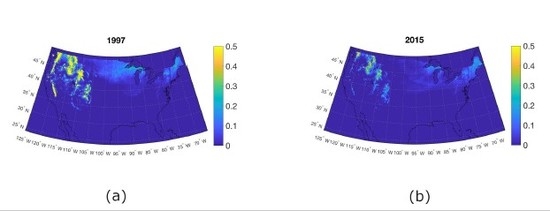Evaluating the Preconditions of Two Remote Sensing SWE Retrieval Algorithms over the US
Abstract
:1. Introduction
2. Interpolated In Situ SWE Data over US
3. Simple Scattering Model for Dry Snow
4. Using Dual Polarization Dual Frequency Backscattered Power to Estimate SWE
4.1. Snow in the US with Satisfying SWE Retrieval Limitations
4.2. Sensitivity of Retrieval to Different Parameters
5. Using Differential Interferometry to Estimate SWE
5.1. Snow in US with Satisfying SWE Retrieval Limitations
5.2. Sensitivity of Retrieval to Different Parameters
6. Conclusions
Author Contributions
Funding
Acknowledgments
Conflicts of Interest
Appendix A
Appendix Generating Interpolated In Situ Data
- The ratio of observed SWE over estimated net snowfall (accumulated snowfall minus accumulated snow ablation), rather than SWE itself, is used for interpolation from point measurements to other points or pixels [21].
- The snowfall versus rainfall is separated using a daily 2-m air temperature threshold based on station data, and the snow ablation is also estimated as a function of temperature based on station data [21].
- A new snow density parameterization [22] is developed to combine the SWE and snow depth measurements from hundreds of snow telemetry (SNOTEL) sites with the snow depth measurements from thousands of continuity of operations (COOP) sites. This snow parameterization is driven by PRISM (the parameter-elevation regressions on independent slopes model) 4 km daily precipitation and temperature data and it includes up to 10 snow layers (depending the total SWE). Each day, the snow mass and snow depth for each layer, and total snowpack liquid water, are updated. This parameterization, which directly includes the impact of total snowpack liquid water on snowpack density, has been validated using the SNOTEL snow density data [22].
- Liquid water increment in the snowpack due to snowmelt is estimated as a function of daily 2-m air temperature. The total snowpack liquid water is part of the total SWE that is interpolated (see the first step) from in situ measurements of SWE from SNOTEL sites and snow depth from COOP sites (which are used along with our snow density model (see the third step) to obtain the in situ SWE). In other words, the snowpack liquid water product is constrained by in situ SWE and snow depth measurements, but it has not been validated itself due to the lack of direct measurements.
References
- Pulliainen, J.; Hallikainen, M. Retrieval of regional snow water equivalent from space-borne passive microwave observations. Remote Sens. Environ. 2001, 75, 76–85. [Google Scholar] [CrossRef]
- Kelly, R.E.; Chang, A.T.; Tsang, L.; Foster, J.L. A prototype AMSR-E global snow area and snow depth algorithm. IEEE Trans. Geosci. Remote Sens. 2003, 41, 230–242. [Google Scholar] [CrossRef] [Green Version]
- Takala, M.; Luojus, K.; Pulliainen, J.; Derksen, C.; Lemmetyinen, J.; Kärnä, J.P.; Bojkov, B. Estimating northern hemisphere snow water equivalent for climate research through assimilation of space-borne radiometer data and ground-based measurements. Remote Sens. Environ. 2011, 115, 3517–3529. [Google Scholar] [CrossRef]
- Kelly, R. The AMSR-E Snow depth algorithm: Description and initial results. J. Remote Sens. Soc. Jpn. 2009, 29, 307–317. [Google Scholar]
- Painter, T.H.; Berisford, D.F.; Boardman, J.W.; Bormann, K.J.; Deems, J.S.; Gehrke, F.; Hedrick, A.; Joyce, M.; Laidlaw, R.; Marks, D.; et al. The Airborne Snow Observatory: Fusion of scanning LiDAR, imaging spectrometer, and physically-based modeling for mapping snow water equivalent and snow albedo. Remote Sens. Environ. 2016, 184, 139–152. [Google Scholar] [CrossRef] [Green Version]
- Cui, Y.; Xiong, C.; Lemmetyinen, J.; Shi, J.; Jiang, L.; Peng, B.; Li, H.; Zhao, T.; Ji, D.; Hu, T. Estimating Snow Water Equivalent with Backscattering at X and Ku Band on Absorption Loss. Remote Sens. 2016, 8, 505. [Google Scholar] [CrossRef] [Green Version]
- Leinss, S.; Parrella, G.; Hajnsek, I. Snow Height Determination by Polarimetric Phase Differences in X-Band SAR Data. IEEE J. Sel. Top. Appl. Earth Obs. Remote Sens. 2014, 7, 3794–3810. [Google Scholar] [CrossRef] [Green Version]
- Leinss, S.; Wiesmann, A.; Lemmetyinen, J.; Hajnsek, I. Snow Water Equivalent of Dry Snow Measured by Differential Interferometry. IEEE J. Sel. Top. Appl. Earth Obs. Remote Sens. 2015, 8, 3773–3790. [Google Scholar] [CrossRef] [Green Version]
- Oveisgharan, S.; Zebker, H. Estimating Snow Accumulation From InSAR Correlation Observations. IEEE Trans. Geosci. Remote Sens. 2007, 45, 10–20. [Google Scholar] [CrossRef]
- Lemmetyinen, J.; Derksen, C.; Rott, H.; Macelloni, G.; King, J.; Schneebeli, M.; Wiesmann, A.; Leppanen, L.; Kontu, A.; Pulliainen, J. Retrieval of Effective Correlation Length and Snow Water Equivalent from Radar and Passive Microwave Measurements. Remote Sens. 2018, 10, 170. [Google Scholar] [CrossRef] [Green Version]
- Yueh, S.H.; Xu, X.; Shah, R.; Kim, Y.; Garrison, J.L.; Komanduru, A.; Elder, K. Remote Sensing of Snow Water Equivalent Using Coherent Reflection From Satellite Signals of Opportunity: Theoretical Modeling. IEEE J. Sel. Top. Appl. Earth Obs. Remote Sens. 2017, 10, 5529–5540. [Google Scholar] [CrossRef]
- Rott, H.; Yueh, S.H.; Cline, D.W.; Duguay, C.; Essery, R.; Haas, C.; Heliere, F.; Kern, M.; Macelloni, G.; Malnes, E. Cold regions hydrology high-resolution observatory for snow and cold land processes. Proc. IEEE 2010 2010, 98, 752–765. [Google Scholar] [CrossRef] [Green Version]
- Ulaby, F.T.; Stiles, W.H. The active and passive microwave response to snow parameters: 2. Water equivalent of dry snow. J. Geophys. Res. Ocean. 1980, 85, 1045–1049. [Google Scholar] [CrossRef]
- Nghiem, S.V.; Tsai, W.Y. Global snow cover monitoring with spaceborne Ku: Band scatterometer. IEEE Trans. Geosci. Remote Sens. 2001, 39, 2118–2134. [Google Scholar] [CrossRef] [Green Version]
- Durand, M.; Liu, D. The need for prior information in characterizing snow water equivalent from microwave brightness temperatures. Remote Sens. Environ. 2012, 126, 248–257. [Google Scholar] [CrossRef]
- Marshall, H.P.; Koh, G. FMCW radars for snow research. Cold Reg. Sci. Technol. 2008, 52, 118–131. [Google Scholar] [CrossRef]
- Shah, R.; Xu, X.; Yueh, S.; Chae, C.S.; Elder, K.; Starr, B.; Kim, Y. Remote Sensing of Snow Water Equivalent Using P-Band Coherent Reflection. IEEE Geosci. Remote. Sens. Lett. 2017, 14, 309–313. [Google Scholar] [CrossRef]
- Guneriussen, T.; Hogda, K.A.; Johnsen, H.; Lauknes, I. InSAR for estimation of changes in snow water equivalent of dry snow. IEEE Trans. Geosci. Remote Sens. 2001, 39, 2101–2108. [Google Scholar] [CrossRef]
- Rott, T.N.H.; Scheiber, R. Snow mass retrieval by means of SAR interferometry. In Proceedings of the 3rd Fringe Workshop Eur. Space Agency Earth Observ, Frascati, Italy, 1–5 December 2003. [Google Scholar]
- Deeb, E.J.; Forster, R.R.; Kane, D.L. Monitoring snowpack evolution using interferometric synthetic aperture radar on the North Slope of Alaska. Int. J. Remote Sens. 2011, 32, 3985–4003. [Google Scholar] [CrossRef]
- Broxton, P.; Dawson, N.; Zeng, X. Linking snowfall and snow accumulation to generate spatial maps of SWE and snow depth. Earth Space Sci. 2016, 3, 246–256. [Google Scholar] [CrossRef] [Green Version]
- Dawson, N.; Broxton, P.; Zeng, X. A new snow density parameterization for land data initialization. J. Hydrometeorol. 2017, 18, 197–207. [Google Scholar] [CrossRef] [Green Version]
- Hallikainen, M.; Ulaby, F.; Abdelrazik, M. Dielectric properties of snow in the 3 to 37 GHz range. IEEE Trans. Antennas Propag. 1986, 34, 1329–1340. [Google Scholar] [CrossRef]
- Mätzler, C. Improved Born Approximation for Scattering of radiation in a granular medium. J. Appl. Phys. 1998, 83, 6111–6117. [Google Scholar] [CrossRef]
- Tsang, L.; Kong, J.A.; Shin, R. Theory of Microwave Remote Sensing; Wiley-Interscience: New York, NY, USA, 1985. [Google Scholar]
- Tsang, L.; Kong, J.A. Scattering of electromagnetic waves from random media with strong permittivity fluctuations. Radio Sci. 1981, 16, 303–320. [Google Scholar] [CrossRef]
- Oh, Y.; Sarabandi, K.; Ulaby, F. An Empirical Model and an Inversion Technique for Radar Scattering from Bare Soil Surfaces. IEEE Trans. Geosci. Remote Sens. 1992, 30, 370–381. [Google Scholar] [CrossRef]
- Yueh, S.; Dinardo, S.; Akgiray, A.; West, R.; Cline, D.; Elder, K. Airborne Ku-Band Polarimetric Radar Remote Sensing of Terrestrial Snow Cover. IEEE Trans. Geosci. Remote Sens. 2009, 47, 3347–3364. [Google Scholar] [CrossRef] [Green Version]
- Hensley, S.; Moller, D.; Michel, S.O.T.; Wu, X. Ka-Band Mapping and Measurements of Interferometric Penetration of the Greenland Ice Sheets by the GLISTIN Rada. IEEE J. Sel. Top. Appl. Earth Obs. Remote Sens. 2016, 9, 2436–2450. [Google Scholar] [CrossRef]
- Montomoli, F.; Macelloni, G.; Brogioni, M.; Lemmetyinen, J.; Cohen, J.; Rott, H. Observations and simulation of multifrequency SAR data over a snow-covered boreal forest. IEEE J. Sel. Top. Appl. Earth Observ. Remote Sens. 2016, 9, 1216–1228. [Google Scholar] [CrossRef]
- Serreze, M.C.; Clark, M.P.; Frei, A. Characteristics of large snowfall events in the montane western United States as examined using snowpack telemetry (SNOTEL) data. Water Resour. Res. 2001, 37, 675–688. [Google Scholar] [CrossRef] [Green Version]
- Tsang, L.; Pan, J.; Liang, D.; Li, Z.; Cline, D.W.; Tan, Y. Modeling active microwave remote sensing of snow using dense media radiative transfer (DMRT) theory with multiple-scattering effects. IEEE Trans. Geosci. Remote Sens. 2007, 45, 990–1004. [Google Scholar] [CrossRef]
- Gabriel, A.K.; Goldstein, R.M.; Zebker, H.A. Mapping small elevation changes over large areas: Differential radar interferometry. J. Geophys. Res. 1989, 94, 9183–9191. [Google Scholar] [CrossRef]
- Zebker, H.A.; Rosen, P.A.; Goldstein, R.; Gabriel, A.; Werner, C.L. On the derivation of coseismic displacement fields using differential radar interferometry: The Landers earthquake. J. Geophys. Res. Solid Earth 1994, 99, 19617–19634. [Google Scholar] [CrossRef]
- Luzi, G.; Noferini, L.; Mecatti, D.; Macaluso, G.; Pieraccini, M.; Atzeni, C.; Schaffhauser, A.; Fromm, R.; Nagler, T. Using a ground-based SAR interferometer and a terrestrial laser scanner to monitor a snow-covered slope: Results from an experimental data collection in Tyrol. IEEE Trans. Geosc. Rem. Sens. 2009, 47, 382–393. [Google Scholar] [CrossRef]
- Molan, Y.E.; Kim, J.W.; Lu, Z.; Agram, P. L-band temporal coherence assessment and modeling using amplitude and snow depth over interior Alaska. Remote Sens. 2018, 10, 1216–1228. [Google Scholar]
- Baduge, A.W.A.; Henschel, M.D.; Hobbs, S.; Buehler, S.A.; Ekman, J.; Lehrbass, B. Seasonal variation of coherence in SAR interferograms in Kiruna, Northern Sweden. Int. J. Rem. Sens. 2016, 37, 370–387. [Google Scholar] [CrossRef]
- Engen, G.; Guneriussen, T.; Overrein, Y. Delta-K interferometric SAR technique for snow water equivalent (SWE) retrieval. IEEE Geosci. Remote Sens. Lett. 2004, 1, 57–61. [Google Scholar] [CrossRef]
- Larsen, Y.; Malnes, E.; Engen, G. Retrieval of snow water equivalent with envisat ASAR in a Norwegian hydropower catchment. In Proceedings of the 2005 IEEE International Geoscience and Remote Sensing Symposium, Seoul, Korea, 29 July 2005; Volume 8, pp. 5444–5447. [Google Scholar]
- Chang, W.; Tan, S.; Lemmetyinen, J.; Tsang, L.; Xu, X.; Yueh, S.H. Dense Media Radiative Transfer applied to SnowScat and SnowSAR. IEEE J. Sel. Top. Appl. Earth Obs. Remote. Sens. 2014, 7, 3811–3825. [Google Scholar] [CrossRef]
- Chang, W.; Ding, K.H.; Tsang, L.; Xu, X. Microwave scattering and medium characterization for terrestrial snow with QCA-Mie and bicontinuous models: Comparison studies. IEEE Trans. Geosci. Remote Sens. 2016, 54, 3637–3648. [Google Scholar] [CrossRef]
- Zeng, X.; Broxton, P.; Dawson, N. Snowpack Change From 1982 to 2016 Over Conterminous United States. Geophys. Res. Lett. 2018, 45, 12940–12947. [Google Scholar] [CrossRef]
- Daly, C.; Halbleib, M.; Smith, J.I.; Gibson, W.P.; Doggett, M.K.; Taylor, G.H.; Curtis, J.; Pasterise, P.P. Physiographically sensitive mapping of climatological temperature and precipitation across the conterminous United States. Int. J. Climatol. 2008, 28, 2031–2064. [Google Scholar] [CrossRef]
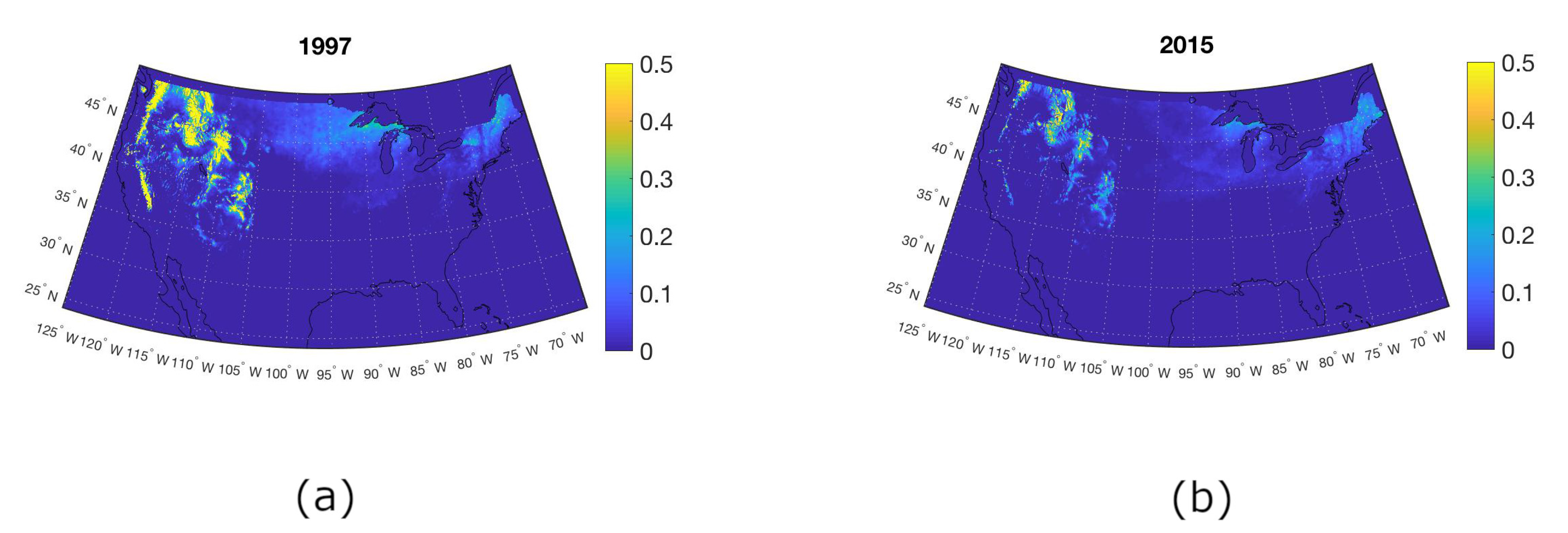
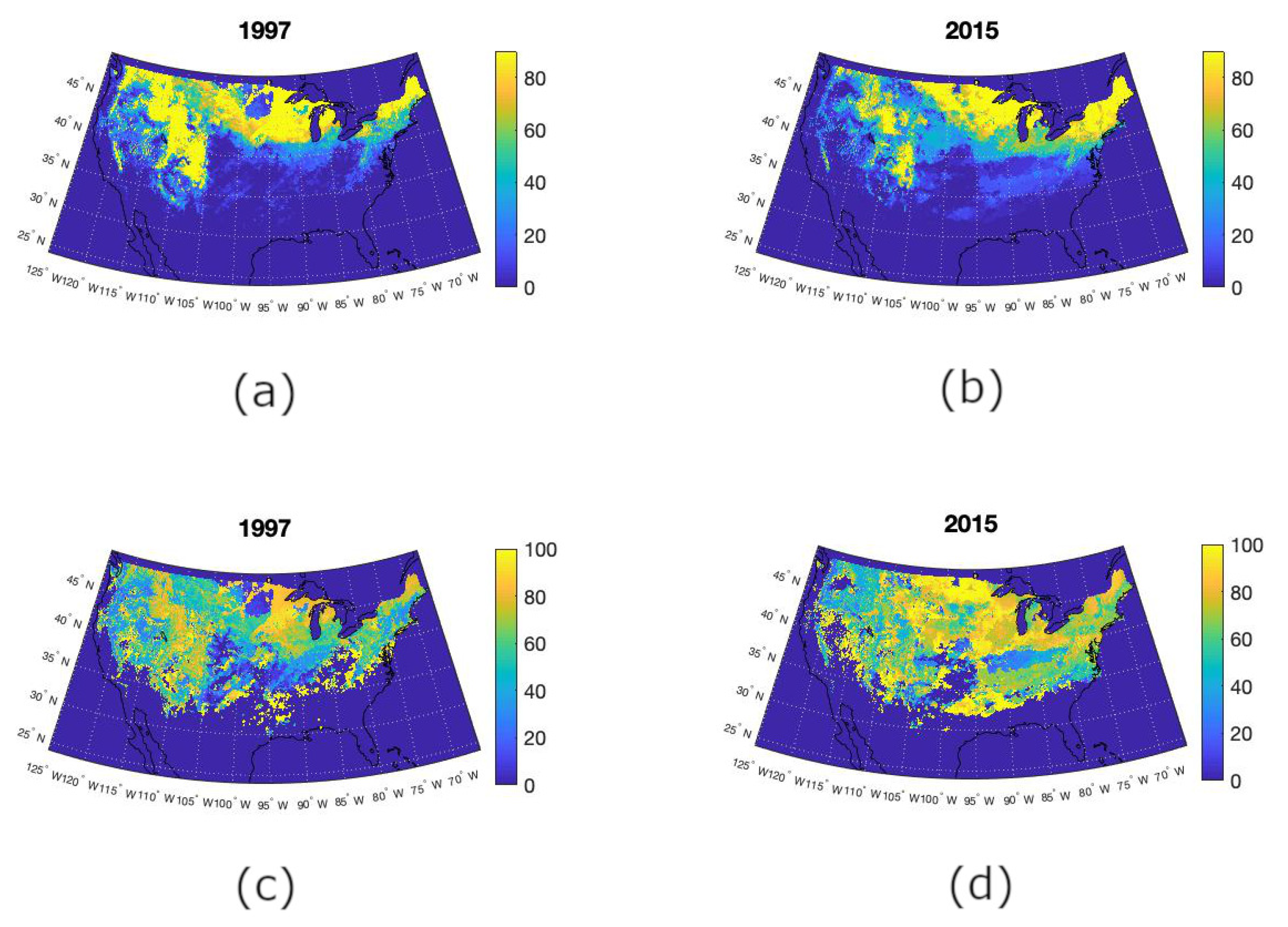

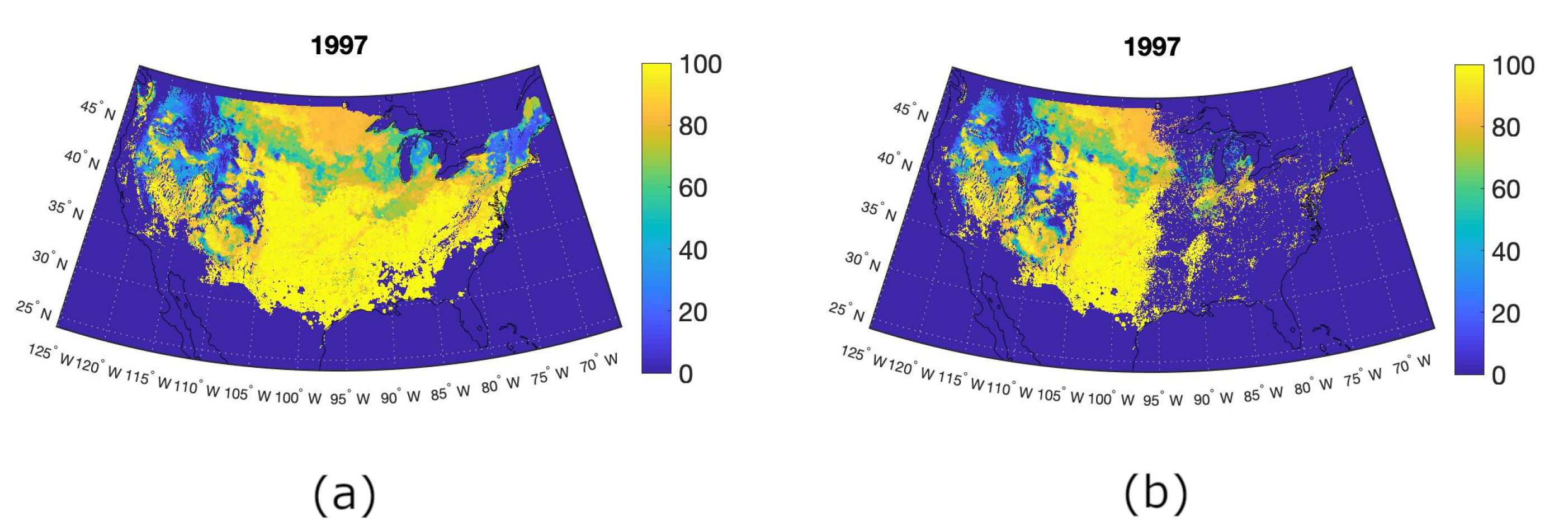




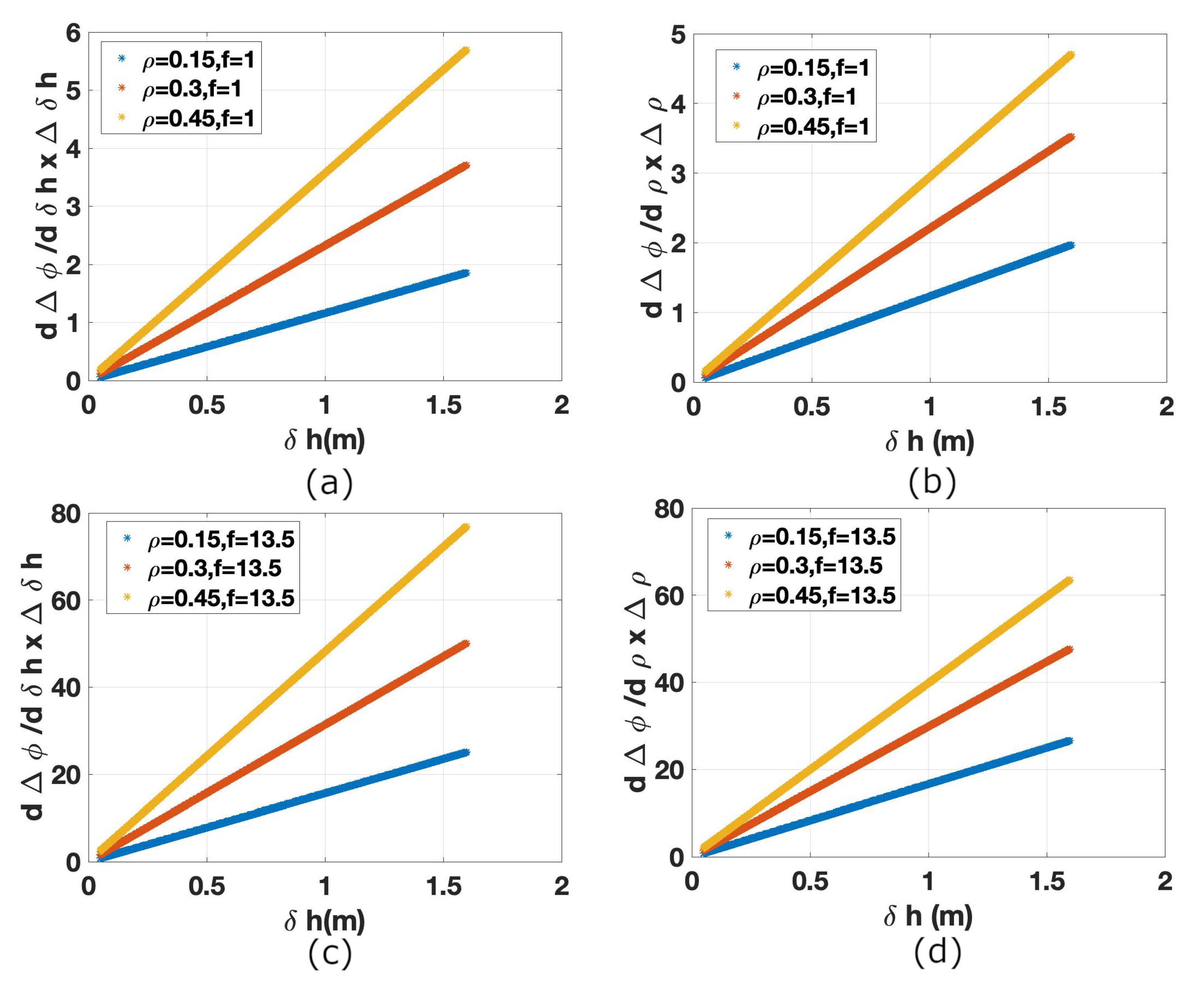
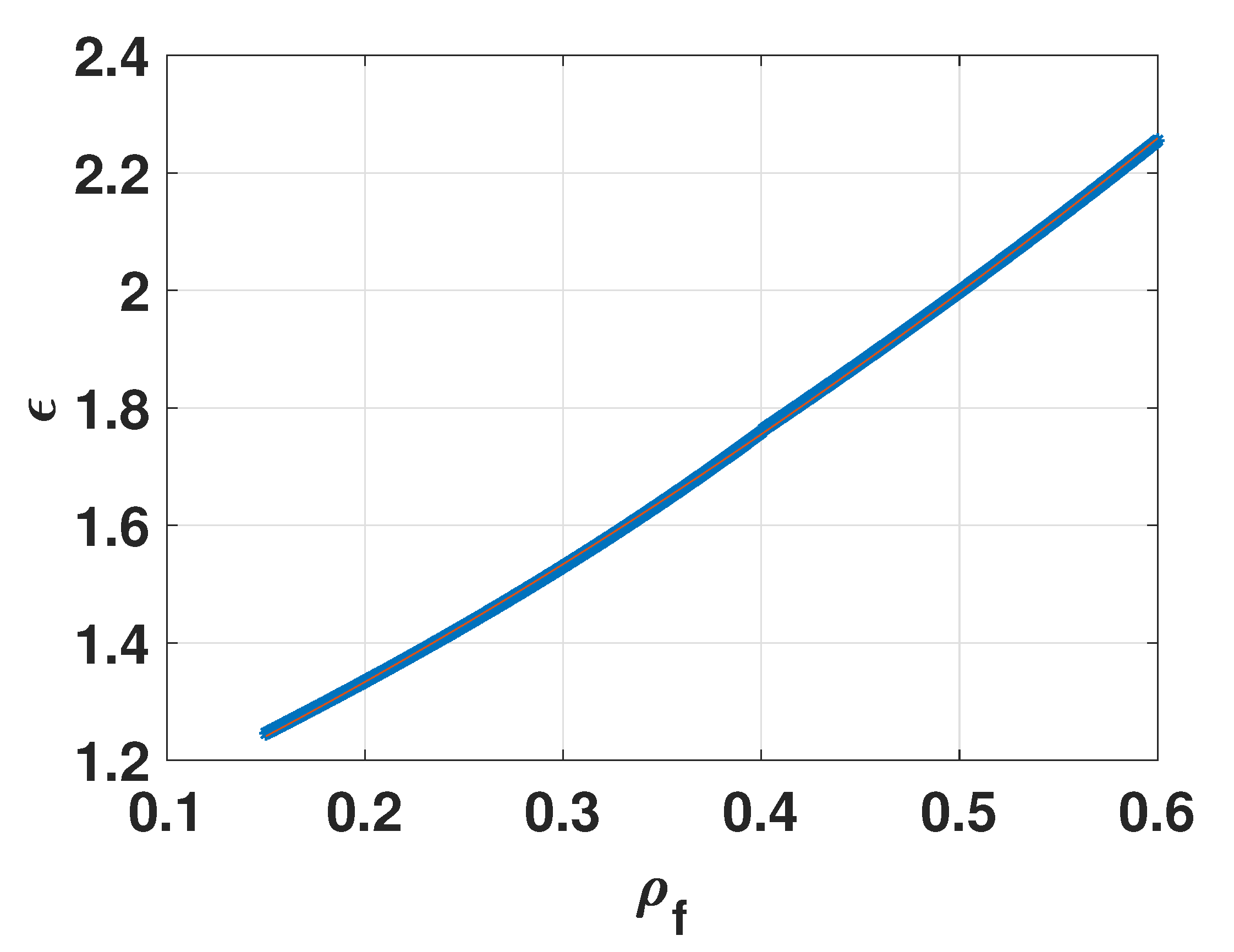
| % points over US | 66 | 66 | 66 | 55 | 55 | 55 | 53 | 53 | 53 |
| , , | |||||||||
| % points over US | 46 | 46 | 46 | 39 | 39 | 39 | 38 | 38 | 37 |
| , , , | |||||||||
| % of SWE over US | 35 | 35 | 35 | 17 | 17 | 17 | 16 | 16 | 16 |
| , , | |||||||||
| % of SWE over US | 23 | 23 | 23 | 11 | 11 | 11 | 10 | 10 | 10 |
| , , , |
| % points over US | 74 | 74 | 74 | 65 | 65 | 65 | 63 | 63 | 63 |
| , , | |||||||||
| % points over US | 47 | 47 | 47 | 44 | 44 | 44 | 43 | 43 | 43 |
| , , , | |||||||||
| % of SWE over US | 41 | 41 | 41 | 20 | 20 | 20 | 18 | 18 | 18 |
| , , | |||||||||
| % of SWE over US | 16 | 16 | 16 | 10 | 10 | 10 | 10 | 10 | 10 |
| , , , |
| % points over US | 77 | 77 | 77 | 58 | 58 | 58 | 55 | 55 | 55 |
| , , daily | |||||||||
| % points over US | 55 | 55 | 55 | 41 | 41 | 41 | 39 | 39 | 39 |
| , , daily , | |||||||||
| % of SWE over US | 72 | 72 | 72 | 19 | 19 | 19 | 17 | 17 | 16 |
| , , daily | |||||||||
| % of SWE over US | 53 | 53 | 53 | 12 | 12 | 12 | 11 | 11 | 11 |
| , , daily , |
| % points over US | 82 | 82 | 82 | 68 | 68 | 68 | 66 | 66 | 66 |
| , , daily | |||||||||
| % points over US | 53 | 53 | 53 | 47 | 47 | 47 | 46 | 46 | 46 |
| , , daily , | |||||||||
| % of SWE over US | 60 | 60 | 60 | 21 | 21 | 21 | 20 | 19 | 19 |
| , , daily | |||||||||
| % of SWE over US | 32 | 32 | 32 | 12 | 12 | 12 | 11 | 11 | 11 |
| , , daily , |
© 2020 by the authors. Licensee MDPI, Basel, Switzerland. This article is an open access article distributed under the terms and conditions of the Creative Commons Attribution (CC BY) license (http://creativecommons.org/licenses/by/4.0/).
Share and Cite
Oveisgharan, S.; Esteban-Fernandez, D.; Waliser, D.; Friedl, R.; Nghiem, S.; Zeng, X. Evaluating the Preconditions of Two Remote Sensing SWE Retrieval Algorithms over the US. Remote Sens. 2020, 12, 2021. https://doi.org/10.3390/rs12122021
Oveisgharan S, Esteban-Fernandez D, Waliser D, Friedl R, Nghiem S, Zeng X. Evaluating the Preconditions of Two Remote Sensing SWE Retrieval Algorithms over the US. Remote Sensing. 2020; 12(12):2021. https://doi.org/10.3390/rs12122021
Chicago/Turabian StyleOveisgharan, Shadi, Daniel Esteban-Fernandez, Duane Waliser, Randall Friedl, Son Nghiem, and Xubin Zeng. 2020. "Evaluating the Preconditions of Two Remote Sensing SWE Retrieval Algorithms over the US" Remote Sensing 12, no. 12: 2021. https://doi.org/10.3390/rs12122021



